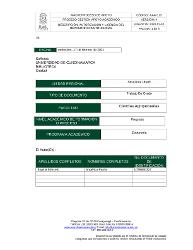| dc.description.abstract | Cuando se han cumplido todas las exigencias de una explotación avícola, se puede
empezar a tomar todas las decisiones posibles para que a medida del tiempo que se va
avanzando, se puedan solucionar cada una de las problemáticas que se presentan,
teniendo en cuenta que el producto que se obtiene en este caso el huevo, se buscan
alternativas para poder mejor calidad, coloración y estabilidad oxidativa, para luego ser
evaluado y poder terminar que características nos arroja después de realizar el análisis del
huevo. Para poder lograr e identificar estas características, se eligen dos materias primas
convencionales maíz (variedad porba), polen (apícola) como complemento, el
concentrado se suministra en los tres tratamientos como suplemento, se escogen 30
gallinas de la línea Hy-line Brown completamente al azar, luego se dividen en tres grupos
para realizar tres tratamientos alimenticios teniendo en cuenta la dieta a suministrar en
cada grupo con el complemento nutricional, se hace un periodo de acostumbramiento y
después se procede a empezar el suministro de los complementos nutricionales, se
observa que para todos los tratamientos hubo diferencias estadísticas (P<0,05)
significativas, para los días de recolección de huevos desde el día 7, ya la pigmentación
otorgada por el maíz y el polen era representativa en los huevos observados con abanico
roche, en la actividad oxidativa pasado los 7 días, hubo menos potencial de oxidación en
los huevos, mediante la escala hedónica; en comparación con los huevos del sistema de
gallina feliz y los huevos comerciales (ALAT S.A.), no hubo diferencias ya que el
concentrado tiene pigmentantes suficiente para la pigmentación de la yema de huevo, el
forraje no afecta la coloración , porque esta alimentación no aporta pigmentantes en el huevo
When all the requirements of a poultry farm have been met, you can start making all
possible decisions so that as time progresses, each of the problems that arise can be
solved, taking into account that the product that the egg is obtained in this case,
alternatives are sought to be able to better quality, coloration and oxidative stability, to then
be evaluated and to be able to determine what characteristics it gives us after performing
the analysis of the egg. In order to achieve and identify these characteristics, two
conventional raw materials (corn-pollen) are chosen as a complement, the concentrate is
supplied in the three treatments as a supplement, 30 hens from the Hy-line Brown line are
chosen completely at random, then They are divided into three groups to carry out three
nutritional treatments, taking into account the diet to be supplied in each group with the
nutritional supplement, a period of accustoming is made and then the supply of nutritional
supplements is started, it is observed that for all treatments There were statistically
significant differences (P <0.05) for the days of egg collection from day 7, and the
pigmentation provided by corn and pollen was representative in the eggs observed with a
Roche fan, in the oxidative activity after the 7 days, there was less oxidation potential in the
eggs, using the hedonic scale; Compared with the eggs of the happy hen system and commercial eggs (ALAT SA), there were no differences since the concentrate has sufficient
pigmentation for the pigmentation of the egg yolk, the forage does not affect the coloration,
because this diet does not provide pigmenting in the egg. | es_CO |


